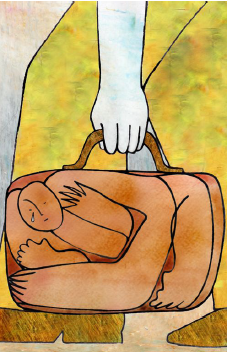 |
| No más trata de personas” IOM Costa Rica Campaign" |
By Michela Macchiavello
Migrants, and particularly those in an irregular situation, are highly vulnerable to exploitation and abuse, but only a few are ever identified as victims of trafficking. During their journey, they risk injury and violence at the hands of smugglers and other criminal groups. Many also experience the hazards of unsafe travel in overcrowded boats, inside closed trucks, atop trains, or on foot through vast deserts.
Others are left stranded en route, abandoned by smugglers or unable to continue their journey due to injury, illness, or crimes committed against them. Criminal groups in several parts of the world have expanded their realm of activity to include kidnapping migrants in order to extort large sums of money from relatives. In some cases, human organs have been forcibly removed from those unable to pay. Upon arrival at destination, migrants risk exploitation and abuse because of the frequency with which they are employed in unregulated or informal-sector activities by unscrupulous employers. Women and children, in particular, are subjected to gender-based violence throughout the migration process.
Although Trafficking in Persons in times of crises has gathered momentum and several international organizations developed approaches to address human trafficking, the phenomenon remains a serious crime, with grave human rights violations, that are largely overlooked in crisis situations by both governmental and non-governmental actors.
Identifying cases of Trafficking in Persons is hampered by definitional difficulties, a lack of knowledge and the existence of grey areas between trafficking and other forms of exploitation. In addition, Trafficking in Persons is typically not considered as a direct consequence of the crisis. This misplaced assumption often hampers the field response to human trafficking cases, not only in terms of documentation, reporting, identification and assistance to the victims, but also in the subsequent criminal investigation.
Counter-Trafficking efforts are not necessarily understood as immediate life-saving in an emergency situation. In reality, these efforts are a matter of life and livelihood for the Victims of Trafficking and should therefore be considered with as much priority as for any other crisis affected population. IOM has recently concluded a research exploring the link between trafficking, armed conflict and natural disasters. This research study concludes that trafficking in crisis exists, and specifically that forms of exploitation that were present in a country before the crisis tend to get exacerbated and also that new crisis-induced exploitation forms come into being. Amongst others things, this report recommends that Trafficking in Persons be addressed from the outset of emergencies by coordinated actions between the humanitarian and development community.
As Maria Grazia Giammarinaro*, Special Rapporteur on Trafficking in Persons said: "trafficking in persons is often a consequence of crisis, not simply a side effect: a new approach is needed" to address the vulnerabilities of crises-affected populations.
Let's remember what writer Ian McEwan wrote: “people are easily torn but not easily mended”: trafficking victims need help to rise above the inhumanity of criminals.
“Chaque fois qu'un homme a fait triompher la dignité de l'esprit, chaque fois qu'un homme a dit non à une tentative d'asservissement de son semblable, je me suis senti solidaire de son acte.”
- Frantz Fanon
See Report on Counter trafficking and Assistance to vulnerable migrants.
* at the 29th Human Rights Council, 16 June 2015.